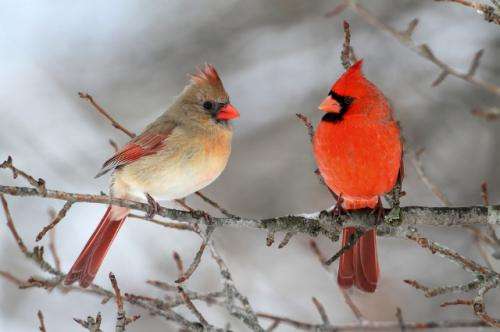It appears that at least some birds can detect subtle changes in air pressure, which can indicate an approaching storm, and they immediately try to get as much food as possible. Credit: Steve Byland/DepositPhotos
Survival in the wild, cruel, pitiless world is a tenuous thing. There are predators trying to eat you, pathogens trying to infect you, rivals trying to beat you. It is truly, as Alfred Lord Tennyson wrote, "Nature, red in tooth and claw." Added to this list of potentially mortal dangers is inclement weather. Severe storms can kill many animals, and birds are no exception. But clearly birds can survive these storms, or else there would be few birds left. Even the hard winter we just experienced has been followed by an eruption of song from our feathered friends. So how do they do it?
The answer is in two parts. The first can be summarized as "location, location, location." There are some advantages to being small, and taking advantage of microhabitats is one. Gale-force winds can claim our hats and destroy our umbrellas, but many birds can seek shelter on the lee side of trees or deep inside thick hedges. The decrease in wind speed in these microhabitats can be huge. So as long as the birds stay put, they are not actually buffeted much by the wind. These areas also can help keep birds dry, even in a driving rainstorm.
Microhabitats can help enormously with cold temperatures. Even though it can be bitterly cold at our nose level several feet above the ground, the temperature can be many degrees warmer just a few inches above the ground. This effect is magnified even further when the sun is shining. During a bitter nasty day try lying on the ground for a few minutes, especially behind something that breaks the wind. You'll discover that conditions improve enormously. In fact, much of the remaining discomfort will likely come from the cold, wet ground that you're lying on.
Which brings me to the second way that birds survive storms—preparation.
Preparation comes in two parts. The first is preparation through evolution. Birds are exquisitely adapted to survive in bad weather. It starts with the feet. Although that cold, wet ground is uncomfortable for you, it isn't particularly uncomfortable for a bird. Those spindly little legs have a wonderful adaptation called counter-current exchange. We mostly lose heat, and thus feel cold, from hot blood in the skin radiating heat to the cold air. The loss of heat brings cold blood back to our body's core, which chills us even more.
In birds, the arteries with hot blood running to the feet pass right next to the cold blood running in the veins back to the body. With this arrangement, the hot blood in the arteries passes heat to the cold blood in the veins before the blood even reaches the feet. The heat is thus returned to the body and results in cold blood in the feet. Cold feet lose very little heat to the cold ground.
A second adaptation is feathers. There is a reason why we covet down jackets for their warmth. The feathers are exquisitely able to trap air. This trapped air prevents cold air from circulating to the skin, thereby creating very effective insulation—and the fluffier the feathers, the better the insulation. Birds can adjust the amount of "fluff" in their feathers. Small birds living in the Arctic can fluff their feathers sufficiently to survive temperatures many dozens of degrees below zero Fahrenheit.
To summarize, bird survival relies upon finding an adequate microhabitat, decreasing activity, and utilizing feathers and counter-current exchange to minimize heat loss. However, the inactivity necessary to optimize these strategies means that the birds cannot forage for food.
This brings us to the last way in which birds prepare for storms. They must increase the amount of stored energy to get them through the period of inactivity. They do this mostly through fat. There are some reports of birds increasing foraging activity as a storm approaches. It appears that at least some birds can detect subtle changes in air pressure, which can indicate an approaching storm, and they immediately try to get as much food as possible. The more fat a bird has, the better chance it has of surviving.
A famous early example was reported in 1899 by Hermon Carey Bumpus, a biologist who went on to serve as president of Tufts from 1915 to 1919. He found that only the largest, and presumably fattest, house sparrows survived a major storm. This should make intuitive sense. The better your energy reserves, the better your chances of surviving a storm. So why aren't all birds as fat as they can possibly be? The answer is those pesky predators discussed at the beginning. A fat bird is also a slow bird, and a much easier target. In the end, the amount of fat a bird is carrying is a trade-off between as little as possible to stay nimble and avoid predators and as much as possible to provide a buffer for surviving severe weather. This type of trade-off is common among wild animals.
So the next time a nasty storm rolls through, wonder at the resourcefulness of the birds, and rejoice in their songs when they re-emerge once the tempest, "full of sound and fury," has passed.
Provided by Tufts University
























